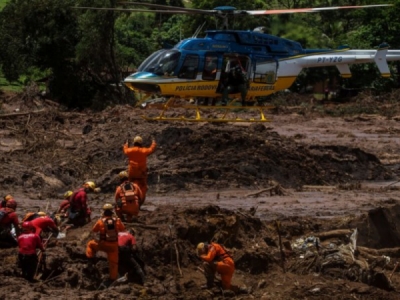
Posted on January 31, 2019
Rescue workers co-ordinate with a helicopter while attempting to remove a body from the debris of a bus after the dam burst in Brazil. Credit:Bloomberg
Shares in Australia’s biggest iron ore miners surged on Wednesday after Brazilian miner Vale said it would shut 10 tailings dams and suspend mining at some of its operations after a horrifying dam failure last week killed scores of people and left hundreds of others missing feared dead.
More than $5.1 billion was added to the market capitalisation of the three biggest Australian iron ore miners, Rio Tinto, BHP and Fortescue Metals Group on Wednesday, on expectations that the Vale move would reduce the amount of iron ore the Brazilian miner could produce and lead to a tighter global iron ore market.
Shares in Rio Tinto rocketed 7.3 per cent to $89.65 in the morning, its highest intraday price since 2008, while BHP rose as much as 4.9 per cent in morning trade before easing, to finish the day up 2.6 per cent at $34.60.
Rio Tinto closed up 4.5 per cent at $87.30, it’s highest closing price in more than a decade, while BHP closed up 2.6 per cent at $34.60, its highest closing price since August 2014.
Andrew “Twiggy” Forrest’s Fortescue Metals Group was up 9.9 per cent (50 cents) to $5.53 at one point, and eventually closed up 7.8 per cent, at $5.42. Ninety-one million shares in FMG were traded, compared to a daily average of 24 million.
Vale said it would decommission 10 dams like the one that collapsed last week, a move that will see mining suspended at the mines associated with those dams.
Vale, the world’s biggest iron ore producer, said it plans to offset the lost production by lifting output elsewhere, but with the company facing mounting costs from the disaster, legal action, investigations and a $US1.3 billion project to decommission dams – the company faces massive challenges. Making up for lost production will not be straightforward.
On the global market, an industry benchmark price for iron ore rose 1.6 per cent to $US79.95 per tonne on Tuesday.
A higher iron ore price delivers more revenue to Australian miners. According to financial results released by BHP last August, a $US1 per tonne increase in the iron ore price adds $US227 million to its earnings before interest, tax, depreciation and amortisation (EBITDA) on a full year basis.
Vale chief executive Fabio Schvartsman said the operations in question produced 40 million tonnes of iron ore per year. This equals about 10 per cent of Vale’s annual output.
“We decided the company should, once and for all, do what it takes to remove any doubt about the safety of Vale’s dams,” he said.
“The company’s decision is that we can no longer live with this type of dam,” he said.
Lachlan Shaw, commodity strategist with UBS, said the Vale move came at a time when the global iron ore market was quite balanced.
“There’s no obvious spare capacity out there, put it that way. The only obvious spare capacity sits within Vale itself, in terms of their northern system,” he said.
“The real issue here is exactly how much production Vale can manage to supply to the market while they go through this period of decommissioning,” he said.
Asked what the dam decommissioning and altered Vale production would mean for Australian iron ore miners, Mr Shaw said: “In all likelihood the market supply and demand balance will be tighter, which means prices will be higher, and there’ll be a situation where some customers of Vale will need to source material from other suppliers.”
Vale’s now infamous Feijao dam in Brumadinho failed suddenly last week, releasing a torrent of mud that rushed down the countryside and swept up hundreds of people.
As at Wednesday morning (Brazilian time) the death toll stood at 84, with 276 still missing.
Source: The Sydney Morning Herald





